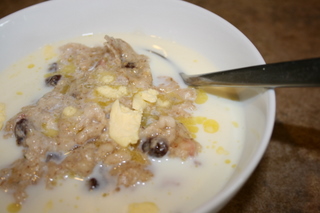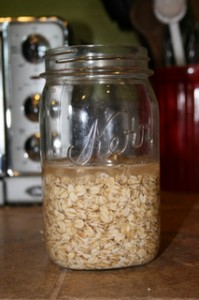Why not our own little tutorial for enjoying the goodness of oatmeal, not only is it nutritious, but it is extremely frugal! I have found the soaking benefits to be very worthwhile and simple. If you are not familiar with the benefits of soaking, please read here. Basically soaking helps to break down phytates in grains which prevent proper digestion of the nutrients. Soaking breaks down the phytates and allows the body to properly absorb all the good content of those whole grains!
Besides the benefits for digesting, soaking also accomplishes a few other helpful things:
- Decreases cooking time – after soaking, you can cook up a batch of oatmeal in less than 5 minutes! Unsoaked oats can take anywhere from 15-25 minutes to cook.
- Provides a porridge texture – we love the porridge consistency of soaked oatmeal. It is not dry like standard oats, but is very smooth and delicious!
- Expands -thus stretching the oatmeal and you get more for your dollar! When you soak oatmeal it absorbs water, thus expanding and becoming more filling at the same time. Whereas unsoaked oatmeal only barely serves two of us (with the following recipe), the soaked version with make 4 significant hearty portions. That’s a frugal way to go with just a little foresight!
Soaked Oatmeal for 4 (multiply as desired)
1 1/2 cups uncooked rolled oats
1 1/2 cups water (to just cover the oats – see picture)
1 Tbsp acid medium (kefir, whey, or yogurt)
1/8 cup ground whole wheat flour (this helps break down the phytates more quickly, according to this article)
1-2 Tbsp ground almonds or other nuts (we use a coffee grinder dedicated to grinding nuts and seeds!), optional
Other toppings: ground flax seed, pumpkin seeds, chopped apples, raisins, shredded coconut flakes
1. I find it easiest to soak my oatmeal in a glass quart size jar. I fill with the oats and just cover slightly with fresh filtered water. But you can use any various container.
2. Add your acid medium, and nuts, as desired. Soaking the nuts help break down their unique phytates as well.
3. Cover with lid and shake to combine. Easy! Takes a matter of 3-4 minutes to get those oats soaking away. Put in a cupboard and allow to soak.
Ideally, it is best to soak oats for 24 hours, because they have the highest level of phytates. Oftentimes that doesn’t happen at our house, but I try to at least get it soaking the night before to get a good 12 hours in.
After soaking, heat up an additional 1 1/4 cups of water. After it boils, add the soaked oats, and any additional toppings you desire. We love chopped apples, raisins and shredded coconut. Turn down temperature to a simmer, and allow to cook for 5 minutes or so. Remove from heat and top with ground flax seeds, if desired.
Serve with butter, honey and fresh milk for a wonderful nutritious breakfast!
The flax seeds and nuts increase fiber and protein! Great for pregnant mommies too!





This looks so good! I often soak my oatmeal overnight in a Ball jar. This http://insidethepeanutgallery.wordpress.com/2013/05/05/easy-overnight-oats/ is my go-to recipe
So when you say use an acid form like Whey, are you referring to Whey Protein? I have never soaked oats before and since I eat oats 1-3 times a day, i def need to start soaking my oats. So oats, water, whey protein? overnight in a warm place. I usually microwave my oats, is this another option after soaking is microwave instead of stove? Thanks for sharing the information, i never knew about any of this.
Tracy, by “whey” she’s referring to the liquid byproduct that forms from fermented dairy products like yogurt and cheese. Whey protein powder is made from whey, but it’s not the same thing. If you don’t have any whey handy (which you probably wouldn’t unless you make your own yogurt) you can substitute lemon juice or vinegar. The acidity of the whey (or lemon juice or vinegar) works to break down the phytic acid around the oats to make them more digestible.
Also, you can definitely microwave oats after soaking; my dad does this every morning. He actually thinks soaking improves the texture of oatmeal.
Hope this helps
Another thing you can do is buy oat groats. Here is what I like to do: http://simplyhomemaking60.blogspot.com/2013/01/oats-again.html
This is to clarify my post; this quote from http://www.rebuild-from-depression.com/blog/2010/02/oatmeal_phytic_acid.html “Taking the lead from another phytic acid study, I have recommended(…) to add a bit of fresh ground wheat, spelt, rye, or buckwheat to the oatmeal and then soaking it. The phytase in these other grains will work to reduce the phytic acid in the oats. I have recommended using about 10% of the complementary fresh ground grain to 90% oatmeal, though often I add a heaping tablespoon to a cup or so of rolled oats. Soak the oatmeal in water above body temperature overnight in a warm spot. Use the same amount of water you usually cook it in and simply throw it all in the pan in the morning. I do not recommend using the yogurt or whey anymore, just stick with the complementary grain for more diligence.
To make this task easy, buy a coffee grinder that you can dedicate to grinding small amount of grain on demand.”
Must the apple cider vinegar be raw? I also add a bit of rye or stone ground whole wheat to the soak as oatmeal does not have significantly high amounts of the needed chemicals for phytate break down as do the aformentioned grains..
Can I keep the soaked oats in the fridge after the twenty four hours? I tend to like to premake a large amount and then store it to use when I am ready. I have done a half and half mixture of yogurt and oats that I soaked overnight and it kept fine in the fridge. I would like to stretch my yogurt a little further though and try it your way.
Yes, but it will get more sour as it sits so its best to cook it up shortly after soaking,
If I make oatmeal (without soaking it) and then have the leftovers the next day…is that the equivalent nutritionally of soaked oatmeal since it has been sitting in the fridge for a day?
Thank you!
No, to soak oatmeal the right way, there must be an acid involved (whey, kefir, etc.). Soaking it in the water/acid solution will make all the nutrients more readily available, thus making the breakfast more filling. It’s awesome not getting hungry just a couple hours after breakfast!
Hope this helps!
Josh
Lindsay, Do you rinse the soaked oats before putting them in to the boiling water?
No, it is not necessary.
Thanks for sharing this! I hope you don’t mind if I linked your page in my latest coconut date oatmeal post. http://doublethink.us.com/paala/2012/05/04/date-coconut-oatmeal/
I keep trying this and I always burn it. I don’t know why. Regular oatmeal doesn’t seem to burn the way this is.
Hmm…I always add the oatmeal and turn it down to a simmer and it is ready in 5 min. It has never burned for me unless I keep it at a high temp.
Stove tops all work so differently. You can have propane, natural gas, traditional electric coil or smooth top. Each will cook, even on “low” at a different temperature. Also, it’s important to use a heavy-bottomed pan or cast iron saucepan. So, when it comes to a boil, turn it to the lowest temperature on your stove and then check it every minute and give it a quick stir. You will know when it is done, and can make sure it doesn’t burn. Good luck!
what do you think about to soak oats with milk and ground whole wheat flour for about 8 – 12 hours?
You want to use a cultured dairy product (kefir or yogurt) for best results in breaking down the phytates. You can also use whey, lemon juice, raw apple cider vinegar.
I’m so glad you mentioned the apple cider vinegar because as I was getting ready to put in my acid medium, I realized, “Ah! I used the last of my yogurt for our smoothies this morning!!” I used ACV hoping that would work. Now I’m glad to read it’s okay to use it. Guess I’ll need to make some yogurt tomorrow.
So I have tried the soaking method using oats, lemon juice, water and wheat flour, letting it soak for 24 hours. And it definitely had a sour taste in the morning. But in all fairness I didn’t cook it prior to eating, but instead we ate it raw, which is what we have been doing for all of the warm months (just without lengthy soaking), since we hate warm oatmeal in the summer. I’m wondering if anyone has any idea if it’s okay to eat it raw after soaking for 24 hours, and if so, should it taste sour? Also, does the cooking process somehow neutralize the sour taste? Cause in all the websites I’ve seen about soaking oats, none of them talk about the oats tasting sour afterwards. (But all of them assume cooking after soaking.)
Thanks!
Hi Jamie,
I use lemon juice as well to soak my oats and after cooking, there is a little bit of a sour taste but it’s palatable and I don’t mind it. I also add a little milk and top with dried cherries/cranberries and walnuts.
Wow, I applaud you for tolerating the sour taste! We thought it had a tremendously sour taste after cooking and my husband barely choked down his bowl. We have just been soaking without the lemon juice. Don’t know if that’s doing much, but we couldn’t find a way to cover up the taste.
Thanks for replying!
My friend has soaked muesli in yogurt over night and then eaten it raw. I wonder if you’d be able to do it with plain oats?
Hi!
I’m not sure if you’ll see this since you posted this so long ago, but I’ll ask anyway:
1. I’m brand new to soaking oats, so I’m not sure if I should soak them before or after I grind them for making baby oatmeal? Do you know?
Thanks so much!